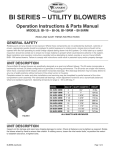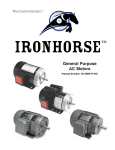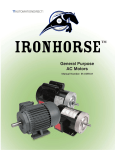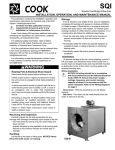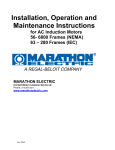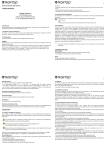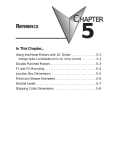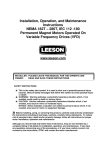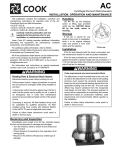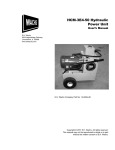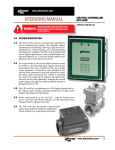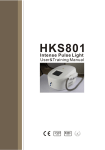Download - Techtop Canada
Transcript
Installation & Maintenance Manual Techtop Canada Inc. 2-2795 Brighton Road Oakville, ON L6H 6J4 www.techtop.com [email protected] ________________________________________ Before you install, operate or perform maintenance, become familiar with the following: NEMA Publication MG-2: Safety Standard for Construction and Guide for Selection, Installation and Use of Electric Motors. IEC 60072-1 Electrical and IEC72-1 Mechanical specifications ANSI C51.5, the National Electrical Code (NEC) and local codes and practices. OSHA standard 1910.147 titled: The Control of Hazardous energy (lockout/tag-out). RECIEVING Once you receive your motor, instantly observe the condition of the shipping container. Immediately report any damage to the commercial carrier that delivered your motor. Verify that the part number of the motor you received is the same as the part number listed on your purchase order. HANDLING Use correct material handling equipment to avoid injury. Use caution when removing the motor from its packaging. Sharp corners may exist on motor shaft, motor key, sheet metal and other surfaces. SAFETY NOTICE ________________________________________ corners may exist on motor shaft, motor key, sheet metal and other surfaces. 1. Connect Power and Ground to the motor according to NEC or IEC and local codes. 2. Provide a permanent guard to prevent accidental contact of body parts or clothing with rotating or moving parts of motor. Beware of burns if motor is hot. 3. Shaft key must be secured before starting motor. 4. Mounting bolts should be high tensile steel. Be sure to use a suitable locking device on each bolt (spring washer or thread lock compound). 5. Do not apply power to the motor until the motor is securely mounted by its mounting holes. 6. This motor must only be connected to the proper line voltage, line frequency and load size. 7. Motors are not to be used for load holding or restraining unless a properly sized brake is installed. If a motor mounted brake is installed, provide proper safeguards in case of brake failure. 8. Disconnect all power services, stop the motor and allow it to cool before servicing. 9. For single phase motors, discharge the start and/or run capacitors before servicing. 10. Do not by-pass or render any inoperative safety devices. GUARDING Only qualified personnel, trained in the safe installation and operation of this equipment, should install this motor. When improperly installed or used, rotating equipment can cause serious or fatal injury. Equipment must be installed in accordance with the National Electrical Code (NEC), local codes and NEMA MG2 Safety Standards for Construction and Guide for Selection, Installation and Use of Electric Motors and Generators and OSHA regulation standard 1910.147 titled: The control of hazardous energy (lockout/tag-out). Use correct material handling equipment to avoid injury. Use caution when removing the motor from its packaging. Sharp After motor installation is complete, a guard of suitable dimensions must be constructed and installed around the motor. This guard must prevent personnel from coming in contact with any moving parts of the motor or drive assembly, but must allow sufficient cooling air to pass over the motor. If a motor mounted brake is installed, provide proper safeguards for personnel in case of brake failure. WARNING: Guards must be installed to form a safe and uncompromised perimeter around rotating parts such as couplings, pulleys, external fans, and unused shaft extensions. 1 2 ________________________________________ ________________________________________ All parts should be permanently guarded to prevent accidental contact by personnel. Accidental contact with body parts or clothing can cause serious or fatal injury. When this motor is installed according to these instructions, it complies with the EEC Machinery Directive. Electromagnetic Compatibility (EMC) requirements for CE compliance are met when the incoming power is purely sinusoidal. or closed systems from which they can only escape through accidental rupture or breakdown of such containers. HAZARDOUS LOCATIONS Ensure that the motor installed is proper for the location in which it will operate. Division 2 motors should never be installed in locations requiring a Division 1 motor. Familiarize yourself with the ratings and the specific details of the motors working environment. CLASS I: (Gases, Vapors) Group A: Acetylene Group B: Butadiene, ethylene oxide, hydrogen, propylene oxide Group C: Acetaldehyde, cyclopropane, diethel ether, ethylene, isoprene Group D: Acetone, acrylonitrite, ammonia, benzene, butane, ethylene dichloride, gasoline, hexane, methane, methanol, naphtha, propane, propylene, styrene, toluene, vinyl acetate, vinyl chloride, xylem CLASS II (Combustible Dusts) Group E: Aluminum, magnesium and other metal dusts with similar characteristics. Group F: Carbon black, coke or coal dust Group G: Flour, starch or grain dust Division 1: In which ignitable concentrations of hazards exists, under normal operating conditions and/or where hazard is caused by frequent maintenance or repair work or frequent equipment failure. Division 2: In which ignitable concentrations of hazards are handled, processed or used, but are normally in closed containers 3 MOUNTING Foot mounted: Foot mounted motors should be mounted to a rigid foundation to prevent excessive vibration. Shims may be used if the location is uneven. Improper alignment may void the motor’s warranty. Flange mounted: Flange mounted motors should be properly seated and aligned. Note: If improper rotation direction is detrimental to the load, check the rotation or ‘bump’ the motor prior to coupling the load to the motor shaft. V-belt drive: Mount the sheave pulley close to the motor housing. Allow clearance for end to end movement of the motor shaft. Do not over tighten belts as this may cause premature bearing failure or shaft breakage. Direct coupled: Direct coupled motors should be carefully aligned and the shaft should rotate freely without binding or drag. NOTE: Techtop Motors with frame 254T and larger are shipped with an opposite drive end bearing lock. If front end bearing locks are desired, please contact Techtop for assistance. GROUNDING Ground the motor according to NEC and local codes. In the USA, consult the National Electrical Code, Article 430 for information on grounding of motors and generators, and Article 250 for general information on grounding. In making the ground connection, the installer should make certain that there is a solid and permanent metallic connection between the ground point, the motor or generator terminal housing, and the motor or generator frame. In non-USA locations consult the appropriate national or local code applicable. 4 ________________________________________ NEMA Three Phase Motors Wiring Diagrams WIRING YOUR MOTOR 3 Phase - YY/Y - 9 Lead GR3 Motors 215T and Smaller Motors Connect the motor as shown in the connection diagram on the motor nameplate. Be sure to identify the proper wiring diagram for the motor you are installing. If you have difficulty determining the proper wiring diagram for your motor, please contact Techtop for assistance. If this motor is installed as part of a motor control drive system, connect and protect the motor according to the control manufacturer’s diagram. When using AC motors with frequency inverters, be certain that the motors maximum speed rating is not exceeded. The wiring, fusing and grounding must comply with the National Electrical Code or IEC and local codes. Note: If improper rotation direction is detrimental to the load, check the rotation or ‘bump’ the motor prior to coupling the load to the motor shaft. When the motor is coupled to the load and started, it should start quickly and run smoothly. If not, stop the motor immediately and determine the cause. Possible causes are: low voltage at the motor, motor connections are not correct or the load is too heavy. Check the motor current after a few minutes of operation and compare the measured current with the nameplate rating. V2 W2 U2 V2 W2 W2 W4 U2 U4 V2 V4 U2 U4 V2 V3 W2 W3 U3 V3 W3 U3 V3 W3 U3 V3 W3 W4 U4 V4 U1 V1 W1 U1 V1 W1 U1 V1 W1 U1 V1 W1 LOW VOLTAGE HIGH VOLTAGE U2 4 5 6 7 8 9 7 8 9 12 10 11 12 10 11 1 2 3 1 2 3 U2 V2 V1 U1 W1 5 V1 W1 6 4 5 6 7 8 9 7 8 9 1 2 3 1 2 3 LOW VOLTAGE HIGH VOLTAGE All 3 Phase - Single Voltage ALL OR3 - GR3 & BL3 (575, 460V) CONNECTIONS 5 4 5 6 10 11 12 7 8 9 7 8 9 4 5 6 12 10 11 12 10 11 7 8 9 1 2 3 1 2 3 1 2 3 460V RUN 230V RUN 796V RUN T1 & T4: Blue / T2 & T5: White / T3 & T6 Orange 1,2,3 Top - 4,5,6 Bottom 215T and Smaller Y 1 2 3 L1 L2 L3 6 4 5 1 2 3 L1 L2 L3 NEMA Single Phase Motor Wiring Diagrams T2 T5 T3 T2 T5 T3 P1 T4 T8 P1 T4 T8 L1 L2 P2 L1 L2 P2 Single Phase Single Voltage RD1 Line- Frame 182T-215T BLUE 31 BLACK WHITE ORANGE BLACK BLACK P1 P2 T5 BLACK T2 BLUE T3 T8 MAIN 2 T4 182/4T BLUE 213/5T Interchange T1 T8 P2 T8 T5 and T8 T5 T5 to Reverse P1 T4 P1 T4 Rotation L1 L2 L1 L2 High Voltage Low Voltage YELLOW U1 5 4 MAIN 1 W2 4 6 2 V2 CONNECTIONS Low Voltage High Voltage BLUE 132 and Smaller Y W2 5 T8 Leads may not be color coded T5 AUX U2 3 Phase - Single Voltage 4 Single Phase Dual Voltage-RD1 Line P: Blue / P2 & T5: Black / T2: White T3: Orange / T8: Red 3 Phase - YY/Y - 9 Lead GR3 Motors 132 and Smaller Motors LOW VOLTAGE HIGH VOLTAGE CONNECTIONS 6 AUX IEC WIRING DIAGRAMS 4,1 Blue / 5,2 White / 6,3 Org / 7 Yl / 8 Blk / 9 RD 1,2,3 Top - 4,5,6,7,8,9 Bottom 1 RED 2 3 Interchage T5 and T8 to Reverse Rotation 6 MAIN 2 213/5T Only 182/4T Only P1 P2 T1 T4 _____________________________________________ ________________________________________ WARNING: Do not touch electrical connections unless you first ensure that power has been disconnected. Please refer to: OSHA standard 1910.147 titled: The Control of Hazardous energy (lockout/tag-out). 8. Install grease drain plug located opposite the grease inlet. WARNING: Surface temperatures of motor enclosures may reach temperatures which can cause discomfort or injury to personnel coming in contact with hot surfaces. Protection should be provided by the user to protect against accidental contact with hot surfaces. Failure to observe this precaution could result in bodily injury. LUBRICATION PROCEDURE Caution: Keep grease clean. Mixing dissimilar grease is not recommended and may result in premature bearing failure. 1. Re-lubrication is recommended when the motor is warm and the shaft is stationary. 2. Remove all dirt and wipe the outside of the grease fills and drains. 3. Clean the grease fitting (or area around grease hole, if equipped with slotted grease screws). If the motor has a purge plug, remove it. Motors can be re-greased while stopped (at less than 80°C) or while running. 4. When applicable, locate the grease inlet at the top of the bearing hub. If the motor is not equipped with grease fitting, clean the area and replace the 1/8-inch pipe plug with grease fitting. 5. Remove grease drain plug located opposite the grease inlet. 6. Apply grease gun to fitting (or grease hole). Too much grease or injecting grease too quickly can cause premature bearing failure. Slowly apply the recommended amount of grease, taking a few minutes or so to apply. 7. Operate the motor for 20 minutes and reinstall the purge plug if previously removed. 7 SUGGESTED LUBRICATION INTERVALS NEMA Frame RPM DUTY INTERVAL 210-360 1800 or less standard 2 years 210-360 1800 or less severe 1 year 210-360 > 1800 standard 6 months 210-360 > 1800 severe 3 months 400-510 1800 or less standard 1 year 400-510 1800 or less severe 6 months 400-510 > 1800 standard 3 months 400-510 > 1800 severe 1 month SUGGESTED LUBRICANT VOLUME NEMA frame Volume (Cubic in) Volume fluid ounces 250 1.00 .55 280 1.25 .69 320 1.50 .83 360 1.75 .97 400 2.25 1.2 440 2.75 1.5 500 3.00 1.7 MAXIMUM SIDE LOADING When application calls for significant side loading of the motor, the application may require roller bearings to avoid early life failure of motor. 8 ________________________________________ Properly asses the resultant side load before installing your motor. If your side load exceeds the value shown in the table, please contact Techtop to explore options for use of roller bearings. Allowable Side Load for Ball Bearing Motors Frame Size 143T 145T 182T 184T 213T 215T 254T 256T 284T 286T 324T 326T 364T 365T 404T 405T 444T 445T 447T 449T 3600 RPM 106 109 180 180 230 230 470 470 570 570 660 660 820 820 1800 RPM 154 154 227 227 300 300 593 589 735 735 860 850 1080 1080 1270 1290 1560 1520 1450 1490 1200 RPM 179 176 260 260 350 350 703 705 838 838 990 980 1240 1240 1450 1480 1760 1760 1660 1660 If the application calls for significant thrust loads, please contact Techtop to determine if you have the correct motor for your application. 9 ________________________________________ NOTES 1. Overhung loads are considered to include belt tension and sheave weight. 2. Belt loads considered to act in a vertically downward direction. 3. To determine load at shaft end subtract 15%. 4. Overhung load radial limits are based on a bearing L-10 life of 26,280 hours. 5. Overhung load limits don’t include effects of any unbalanced magnetic pull. CONDENSATE DRAINS Many Techtop motors come standard with one way sintered brass breather drains. These drains allow the motor to expel liquids from the casing without allowing liquid to enter the motor. Drains may require periodic maintenance to keep them clean of debris and flowing freely. Occasionally, remove the brass drains and wash them thoroughly. Eliminate any built up debris which may be impeding their operation. For motors which are equipped with rubber plugs in their condensate drain holes, be sure to remove the plug (i.e. especially if the motor is installed in a location where condensate build up is likely). In all instances, ensure that the drain is in the lowest portion of the motor. Some motors may require rotation of the end plates (i.e. if the mounting location is not a typical horizontal mounting). SEAL REPLACEMENT Inspect seals regularly for excessive wear which could lead to bearing failure. If significant wear is present, please contact Techtop for replacement seals. 10










